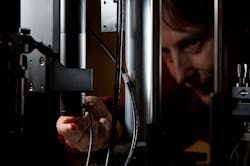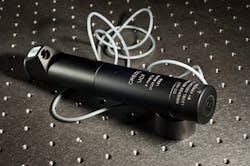In biological and medical science, researchers always want new ways to see more. The scientists seek higher-resolution optics, improvements in noninvasive imaging, and less expensive tools. Let's look at three examples of progress in these areas: A new superlens that spans a broad wavelength range, a liquid lens that enables deep tissue imaging for applications such as diagnostics and therapeutic assessment, and an iPhone-based microscope and spectrophotometer. In each example, the technology supplies new ways to bring more of nature into focus.
Toward tunable nanoscopy
When it comes to making a superlens—an optical device that provides resolution below the roughly 200 nm diffraction limit of light—scientists keep exploring new materials. One ongoing approach comes from Ramamoorthy Ramesh, Plato Malozemoff Professor of Materials Science and Physics at the University of California, Berkeley.
As Ramesh explains: "My expertise is in complex oxides-looking at materials with magnetic and electronic properties, where you can change the material's response to electromagnetism by applying a voltage." For a superlens, in particular, Ramesh uses perovskite oxides, which are ferroelectric.
In thinking of the properties that a superlens should have, Ramesh mentions a broad spectrum-from the ultraviolet, across the visible, and into the far infrared. Although a traditional lens works with specific wavelengths, perovskite oxides can provide a broadband lens.
In a 2011 article in Nature Communications, Susanne Kehr (formerly in Ramesh's lab and now at the University of Saint Andrews in the United Kingdom) and her colleagues described a superlens for wavelengths that cover about 13–19 nm.1 At those wavelengths, it is able to provide a resolution of tens of nanometers. In the next generation of his technology, Ramesh hopes to develop a lens in which electromagnetic fields can tune the device to different wavelengths. "A crude analogy," he says, "is changing a radio station. You turn a knob and a potentiometer picks a different radio station." Similarly, Ramesh envisions a microscope with a superlens that can be tuned just as easily to different wavelengths.
Such a device would provide nanometer resolution across a range of wavelengths, which would give biologists a better view of many objects.
Depth with liquid
From the first time that you looked through a magnifying glass until you gazed through a sophisticated binocular microscope, glass enlarged the images—glass in the objective and ocular lenses. In fact, to a biologist, the concept of a microscope lens means glass. As the perovskite oxide-based superlens showed, though, other materials can be used.
At the University of Rochester in upstate New York, Jannick Rolland, Brian J. Thompson Professor of Optical Engineering, and her colleagues developed the first microscope optics with an embedded liquid lens. She developed this novel optical system to explore deeper into tissues. Rolland says that the "liquid-lens optics can refocus a light beam in the skin or tissue without moving parts. Nothing else has to change." She adds, "We don't want the moving parts."
In a prototype device, a drop of water and a drop of oil replace the glass in the objective lens. An electric field can change the shape of the oil-water interface, which adjusts the focus. That adjustment moves the focal plane precisely up and down in the skin or tissue.
For light, this device uses a broadband—120 nm—laser centered at 800 nm. Then, the liquid-lens optics and associated electronics create a lateral resolution of 2 μm and reach to depths of 0.7 mm into human skin.
In just seconds, this liquid-lens system can capture a sharp two-dimensional image in depth. Also, a collection of these images from a range of lateral scans can be combined to create a three-dimensional image. Even that only takes minutes.
The results show a range of features beneath the skin's surface. "You can see the layers very well," says Rolland. "The sweat glands are at very high resolution." This system also reveals cells and their locations. That can be especially useful in studying cancer, because the skin-cell layers can be less defined and cells can end up in the wrong spots.
This technology offers many potential applications. It could be used to explore basic features of sub-surface structures. It could also be used as a diagnostic, say, for skin cancer. It could even be used to assess the efficacy of a therapy, such as looking for proper skin structure after a treatment.
Smartphone-scope
Rather than turning to natural materials, like water, researchers can advance optics with human-made technology, including smartphones. As the cameras in these devices improve, more options emerge—including making a microscope. Sebastian Wachsmann-Hogiu, associate professor of pathology and laboratory medicine and facility director at the Center for Biophotonics Science and Technology at the University of California, Davis, says: "We take advantage of several features of smartphones, such as a good camera and optics, to build a microscope that can help visualize objects as small as several micrometers." By exploiting these characteristics, Wachsmann-Hogiu hopes to make a device that easily allows biological measurements and even diagnostics in the field.
Although Wachsmann-Hogiu developed this microscope on an iPhone, it would work on any smartphone in which the detector's pixels are 1–2 μm across. In terms of hardware, the conversion only requires attaching a lens over the smartphone's camera. Wachsmann-Hogiu attaches a microlens that is just 1–3 mm across. "The smaller the radius, the larger the magnification," he says, but these lenses only magnify an image by five times or less. The real magnification takes place on the display, which can be enlarged by about 350 times. Overall, this smartphone-scope creates a lateral resolution of about 1.5 μm. Even focusing is easy: You just place the phone near the object to image, and the smartphone's autofocus does the rest.
Beyond a microscope, Wachsmann-Hogiu can also turn a smartphone into a spectrophotometer just by adding a small grating and tube over the camera. "It can quantitatively record color across the visible spectrum," says Wachsmann-Hogiu.
Sometimes, innovation only takes a tweak here or a twist there. At other times, researchers break boundaries, like replacing glass with liquid. The results can be, well, eye-opening.
REFERENCE
1. S.C. Kehr et al., Nature Comm., 2, 249 (2011).
About the Author
Mike May
Contributing Editor, BioOptics World
Mike May writes about instrumentation design and application for BioOptics World. He earned his Ph.D. in neurobiology and behavior from Cornell University and is a member of Sigma Xi: The Scientific Research Society. He has written two books and scores of articles in the field of biomedicine.


